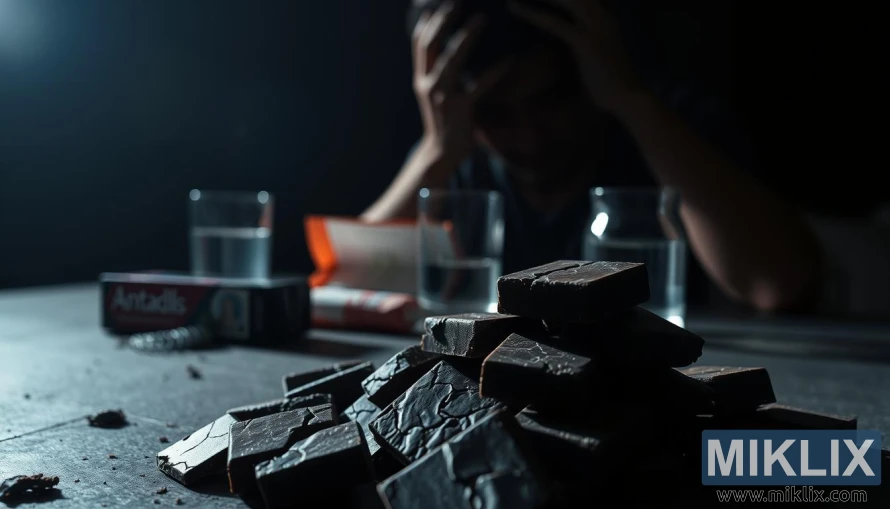Image: Potential downsides of dark chocolate
Published: May 16, 2025 at 1:24:38 PM UTC
Last updated: September 25, 2025 at 8:33:22 PM UTC
Still life of cracked dark chocolate with antacids, water, and a shadowy figure, symbolizing digestive issues and headaches linked to chocolate.
This image presents a strikingly somber still life that explores the lesser-discussed consequences of indulgence in dark chocolate. The foreground immediately commands attention with a pile of broken chocolate squares, their uneven surfaces and sharp cracks suggesting not just imperfection but an underlying tension. Unlike the glossy, refined imagery often associated with gourmet chocolate, these pieces appear raw and fractured, their jagged edges a metaphor for the less harmonious effects of overconsumption. The chocolate’s matte finish, flecked with subtle blemishes, hints at bitterness, both in flavor and in consequence, setting the tone for a narrative that contrasts sharply with the usual celebratory depictions of this beloved treat.
The middle ground introduces more explicit symbols of discomfort: a partially opened box of antacids lies carelessly beside two glasses of water. These elements suggest relief from symptoms such as indigestion, acid reflux, or stomach upset, which can accompany excessive intake of rich, cocoa-heavy foods. Their casual yet deliberate placement reinforces the idea of cause and effect—the indulgence represented by the chocolate countered by the necessity of remedies. The glasses of water, clear and utilitarian, act as visual foils to the richness of the chocolate, representing the body’s instinctive reach for cleansing simplicity when weighed down by excess.
In the background, the tone of the composition deepens into something almost psychological. A blurred figure emerges, seated with head bowed and hands pressing against their temples. Though rendered indistinct, the silhouette is enough to convey distress, evoking the throbbing headaches or migraines that some individuals associate with chocolate consumption. The anonymity of the figure allows them to stand in as a universal representation of struggle, making the image resonate on a human level rather than a purely illustrative one. This shadowed presence introduces a layer of emotional weight, transforming the composition from a still life into a quiet commentary on the hidden costs of pleasure.
Lighting plays a pivotal role in heightening the atmosphere. The scene is enveloped in chiaroscuro, with sharp contrasts between light and dark shaping the emotional tone. The chocolate in the foreground is starkly illuminated, every crack and fracture clearly defined, while the background figure sinks into darkness, their pain more implied than explicitly shown. This interplay between visibility and obscurity creates a sense of imbalance, mirroring the dissonance between the sensory delight chocolate offers and the physical toll it may exact in certain circumstances. The shallow depth of field further amplifies this imbalance, forcing the viewer’s eye toward the immediate, tactile presence of the chocolate before allowing them to process the more distant, shadowy narrative of discomfort.
What emerges from this layered arrangement is a cautionary tale. Dark chocolate, so often celebrated for its antioxidants, cardiovascular benefits, and mood-enhancing compounds, is here reframed within the context of overindulgence and sensitivity. For some, its caffeine and theobromine content can act as triggers for migraines or restlessness. For others, its richness may exacerbate digestive issues. The image underscores the importance of moderation, acknowledging that even foods hailed as “superfoods” carry complexities that vary from person to person.
This tension between desire and restraint is what gives the photograph its evocative power. The pile of chocolate, at once alluring and fractured, embodies temptation in its purest form, while the antacids and distressed figure serve as sobering reminders of consequence. The entire composition feels theatrical yet grounded in real human experience, capturing the precarious balance between indulgence and health. By marrying symbolic props with dramatic lighting and human emotion, the image transforms into more than a cautionary still life—it becomes a meditation on the duality of pleasure, where delight and discomfort exist side by side.
In the end, the photograph lingers in the mind precisely because it refuses to flatter or romanticize its subject. Instead, it dares to expose the shadows behind the sweetness, urging the viewer to recognize that even the most celebrated comforts can carry hidden costs. The result is not a condemnation of chocolate but a nuanced reflection on the delicate art of balance, reminding us that mindful enjoyment is often the key to turning indulgence into genuine well-being.
The image is related to: Bittersweet Bliss: The Surprising Health Perks of Dark Chocolate

